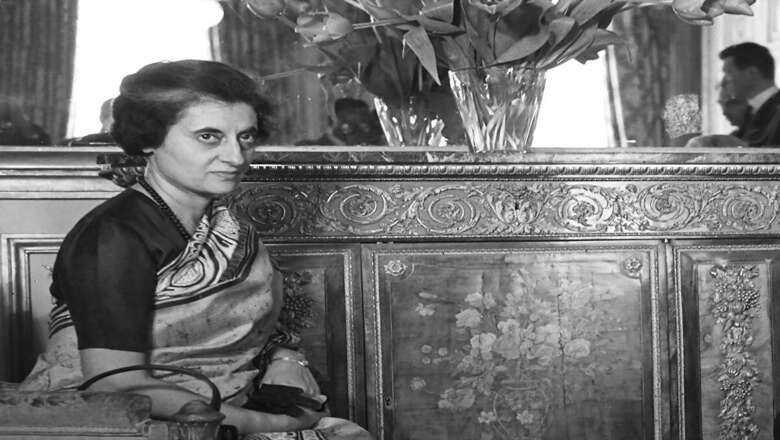
views
Public memory is fickle and fleeting. The passage of time blurs events, even those catastrophic sentinel events that are supposed to be constant reminders of an evil that was aborted. Moreover, the composition of the public is constantly in a state of flux with deaths and new births. Today, the median age in India is 28 years; that means 50 per cent of the population was born after 1996 – nearly 21 years after the Emergency was promulgated by former Congress Prime Minister Indira Gandhi in 1975. The young generation has no firsthand experience of the Emergency and what it meant.
To keep alive the memory of the Emergency becomes all the more difficult. These constellations of factors provide a fertile ground for experimentation in misinformation tactics. This is precisely what Lalu Prasad Yadav, the convicted ex-CM of Bihar, and his personal biographer Nalin Verma are trying to do in their article, What the Sangh doesn’t say about Emergency (I.E June 29, 2024).
Their intention is to whitewash what was unequivocally the darkest period of our history, by creating a false narrative; a narrative that takes recourse to misinformation, selective amnesia and unfair comparisons with the Modi-led BJP government to make its point.
But what is even more unfortunate is that a newspaper which stood tall against the Emergency has bought into this proposition, by providing a bully pulpit to these individuals to mouth their falsehoods, by publishing their opinion piece.
Before we proceed to dissect this opinion piece, it is important to make a distinction between Lalu Prasad Yadav of the 1970s and Lalu Prasad Yadav of now. Then Lalu Prasad Yadav was an idealistic young man inspired by Jayaprakash Narayan and his movement, who spent 15 months in jail under MISA. But much water has flown under the bridge since then. Lalu Prasad Yadav has been convicted and sentenced to jail in 5 fodder scams in which nearly Rs 950 crore were embezzled. The fodder scams were a series of scams that occurred over a span of several years in Bihar and which involved governments belonging to both the INC and the Janata Dal (United).
Today, he is the discredited ex-CM of Bihar convicted in several corruption scandals, wallowing in political oblivion and in the process of trying to rehabilitate the fortunes of his party and his family, by making unprincipled alliances with the party that jailed him. His perspective now is vastly different from what it was in 1975, and needs to be taken not with a pinch but a ton of salt.
In 1975, Indira Gandhi imposed a state of Emergency after the Allahabad High Court found her guilty of electoral malpractice and debarred her from holding public office for six years, essentially stripping her of her position as the Prime Minister of India. Therefore, to claim, as the authors do, that “the then Prime Minister had resorted to constitutional provisions to declare Emergency” is an egregious and audacious attempt to confer a degree of credibility to the Emergency; it is even laughable.
There was nothing constitutional about the move to impose Emergency. To say so is to make mockery of the concept of democracy. It was Indira Gandhi’s avarice for power; an unvarnished attempt to cling to power by blatantly thwarting the rule of the law. To this end, fundamental rights were suspended, Opposition leaders and anyone and everyone who could have posed a threat to her were thrown in jail and the press was muzzled.
The attempt to play down the role of the BJP and the RSS during the Emergency has to be the mother of all lies. Yadav avers that, “Shockingly, Modi and his BJP-RSS friends are ‘enlightening’ the next generation about a period in which they played a dubious role … My colleagues and I did not know many of the BJP ministers speaking about the Emergency today. We hadn’t heard of Modi, J P Nadda….”
The article also lists the names of several stalwarts like Chandra Shekhar (former prime minister), George Fernandes, Mulayam Singh Yadav, Sharad Yadav, Karpoori Thakur who were jailed during the Emergency but deliberately fails to mention the names of BJP leaders like Atal Bihari Vajpayee Advani, Arun Jaitley, the Rajmata of Gwalior and other BJP leaders who were also arrested and spent time in jail.
Nanaji Deshmukh, an RSS-BJP leader, was one of the closest confidants of Jayaprakash Narayan and one of the pillars of the JP movement.
The RSS was one of the first organisations to be banned during the Emergency and played a key role in the underground resistance movement against the Emergency. An article in the London-based magazine The Economist (Jan 24,1976. Yes, there is an Underground) states, “In formal terms, the underground is an alliance of four opposition parties: The Jana Sangh (the RSS’ political wing), the socialist party, the breakaway fraction of the Congress party and the Lok Dal……But the shock troops of the movement come largely from the Jana Sangh and its band affiliate RSS, which claim a combined membership of 10m (of whom 80,000, including 6,000 full-time party workers, are in prison).”
The article also indicates that two of the top four leaders running the underground movement were from the RSS and the Jana Sangh – Dattopant Thengadi, a senior RSS pracharak and Dr Subramanian Swamy.
In order to mitigate the excesses of the Emergency, the duo makes unfair comparisons with the Modi regime by referring to cow slaughter vigilantism, attacks on minorities, anti-national slurs against the Opposition and other unsubstantiated allegations. First, none of these occurrences were officially sanctioned, stemming instead from societal aberrations or the actions of fringe elements. Second, all these incidents, especially the charge of being anti-minority, pale into insignificance when compared to what happened during the Emergency.
The Turkman Gate massacre is one instance of extreme police brutality against minorities that occurred during that period. In April 1976 (the exact date, either 18 or 19, is not clear), during a slum clearance drive coupled with the forced sterilisation program, the government used bulldozers to demolish buildings and run over people. The police callously fired upon those resisting these measures, killing several more. Owing to curbs on the press, the actual death toll was never published. Ashok Chakravarti in his book The Struggle: A Memoir of the Emergency (Harper Collins, 2021), claims that at least 400 people were killed and over 1000 wounded. Others including student activists were also not spared from the atrocities unleashed by the police.
The case of a Kerala student, SS Rajan, needs to be recalled in this context. Rajan, a student of the Calicut Regional Engineering College was arrested on March 1, 1976, subject to inhuman torture like rolling heavy logs over his body, and killed. Rajan’s father carried out a fruitless struggle to know what happened to his son. Despite petitions to the chief minister, home minister and others, he never received a reply. His son’s body was never found. This was the state of India during the Emergency.
Individual freedom of expression and press freedom were the biggest casualties of the Emergency. The degree of suppression that was enforced was total and complete. During this infamous period, The Indian Express stood as a beacon of hope and a standard bearer of democracy. The feisty articles of Arun Shourie and the dogged stubbornness of Ram Nath Goenka, the owner of The Indian Express, were shining examples of commitment to free speech. Ram Nath Goenka not only resisted pressure to relieve Kuldip Nayar (its editor) but also returned from his sick bed (he had a heart attack) to dismiss the government-appointed board overseeing the paper, by invoking procedural rules.
To me, the defining and enduring image of the Emergency remains the blank editorial published in The Indian Express dated June 28, 1975. The message was powerful. Nothing was said but everything was conveyed.
From then to today, it has been a long journey!
The writer is a US-based author. Views expressed in the above piece are personal and solely that of the author. They do not necessarily reflect News18’s views.














Comments
0 comment